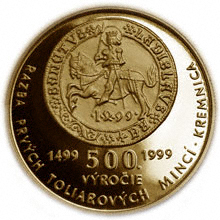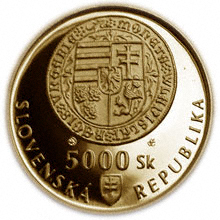Pamětní zlatá mince v hodnotě 5000 slovenských korun k 500. výročí ražby prvních tolarových mincí na Slovensku v Kremnici
Objev bohatých ložisek stříbra ve střední Evropě a
používání nových technologií v hornictví a hutnictví na konci 15.
století zvýšily produkci stříbra a vedly k snaze zavést do oběhu větší
stříbrné mince, které vytvořily základ pro vznik tolarové měny. První
předchůdce tolaru - stříbrný guldiner ( 40 mm, 31.7 g ) vznikl v roce
1486 v Tyrolsku coby ekvivalent zlatého guldenu. V roce 1499 se začaly
guldinery razit i v Kremnici.
Kremnické guldinery patří k nejkrásnějším mincím své doby. V dějinách
mincovnictví hrají významnou roli stejně jako jejich zlaté protějšky
, které patřily mezi první větší zlaté ražby na světě. Známé exempláře
mají váhové rozpětí 16.7 - 68.2 g což představuje ekvivalent 5 - 20 dukátů.
Tyto mince byly raženy v období let 1499 - 1506 a zřejmě byly určeny spíš
k reprezentativním účelům než k zajištění peněžního oběhu.
Podtrhují bohatou tradici hornictví a hutnictví na Slovenském území
stejně jako jeho významnou ekonomickou roli ve světě.
Údaje o minci
Commemorative gold 5000 Slovak crown coin commemorating
the 500th anniversary of the striking of the first thaler coins at Kremnica
Discoveries of deposits of silver in Central Europe and new skills developed
in mining and metallurgy at the end of the fifteenth century increased the
output of silver and led to efforts to tintroduce larger silver coins into
circulation, which laid the foundation for the establishment of a Thaler
currency. The first predecessor to the Thaler - the silver Guldiner ( 40 mm,
31.7 g ) originated in 1486 in the tyrol as the equivalent of the golden
Gulden. In 1499, Guldiners began to be minted in Kremnica as well.
The Kremnica Guldiners rank among the finest coinsof the period and have a
special position in the history of minting as well as their gold variants,
which belongs to the first larger gold coins struck in the world. Preserved
pieces are in the weight range from 16.7 to 68.2 g and represent the
equivalent about 5 to 20 ducats. Silver and gold Guldiners were minted from
1499 to 1506 and were presumably intended more for representative purposes and
as gifts than for the circulation. They represent the long tradition of
minting and metallurgy in the area of Slovakia and reflects its significant
economic position at that time.
Coin´s data
Goldene Gedenkmünze im Wert von 5000 slowakischen Kronen zum 500. Jahrestag der Prägung der ersten Talermünzen in Kremnitz.
Die
Entdeckungen reicher Silbervorkommen in Mitteleuropa und neue, am Ende des 15.
Jahrhunderts im Bergbau und Hüttenwesen verwendete Technologien erhöhten die
Silberproduktion und Führten zu Bemühengen größere Silbermünzen in den
Umlauf einzuführen, die die Grundlagen für die Entstehung der Talerwährung
schufen. Der erste Vorgänger des Talers – der Silberguldiner (40 mm, 31.7
g) entstand im Jahre 1486 in Tirol als Äquivalent des goldenen Guldens. Im
Jahre 1499 begann auch in Kremnitz die Prägung von Guldinern.
Die
Kremnitzer Guldiner gehören zu den schönsten Münzen ihrer Zeit und nehmen
in der Geschichte des Münzwesens eine außergewöhnliche Stellung ein, ebenso
wir ihre Goldabschläge, die zu den ersten größeren Goldprägungen der Welt
gehören. Ihre bekannten Exemplare haben eine Gewichtspanne von 16.7 – 68.2
g, was ein Äquivalent von ca. 5 – 20 Dukaten darstellt. Silberguldiner und
ihre Goldabschläge wurden während des Zeitraums von 1499 – 1506 geprägt,
und waren wahrscheinlich eher für Repräsentationszwecke als Schaustücke und
Geschenke bestimmt, als für den Geldumlauf. sie repräsentieren die reiche
Tradition des Bergbaus und Münzwesens auf dem Gebiet der Slowakei und ihre
damalige bedeutende ökonomische Stellung in der Welt.


